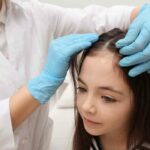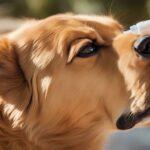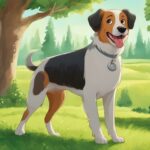
If you are a dog owner, you are probably aware of the discomfort and annoyance that fleas can cause your furry companion. That’s where flea treatment comes in – an effective solution to eliminate fleas and prevent them from coming back. In this section, I will guide you through the steps on how to apply flea treatment to your dog safely and effectively.
Key Takeaways
- Follow the instructions carefully when applying flea treatment to your dog.
- Choose the right flea treatment product for your dog with the help of a veterinarian.
- Prepare your dog by grooming them before applying flea treatment.
- Apply the flea treatment to the back of your dog’s neck or shoulder blades.
- Keep an eye on your dog for any signs of discomfort or side effects after applying flea treatment.
- Maintain a flea-free environment for your dog by regularly treating them and cleaning your home and yard.
Choosing the Right Flea Treatment
When it comes to flea treatment options for your dog, it’s essential to consult with your veterinarian. They can advise on the best product for your dog, taking into account their individual health and lifestyle. The most common flea treatments include topical treatments, oral medications, and flea collars.
Topical treatments are applied directly to your dog’s skin, usually on the back of their neck or between their shoulder blades. They provide fast-acting relief and are effective for up to a month. Oral medications are given to your dog in the form of a pill or chewable tablet. These medications are also fast-acting and effective, but the duration of protection may vary depending on the product. Flea collars are worn around your dog’s neck and release a pesticide that repels fleas and ticks. They can be effective for up to eight months but may not be suitable for all dogs.
It’s crucial to read the instructions carefully and follow the dosage guidelines to ensure the safety and effectiveness of the flea treatment. Keep in mind that some products may not be suitable for dogs with certain medical conditions or on certain medications. Always consult with your veterinarian on the appropriate flea treatment for your dog.
Preparing for the Application
Before applying flea treatment, it is important to prepare your dog to ensure maximum effectiveness and safety. Here are some essential steps to follow:
Grooming
Groom your dog by giving them a good bath with a flea shampoo. Towel dry them and remove any excess water. Use a flea comb to remove any existing fleas or eggs. This ensures that the flea treatment can reach your dog’s skin effectively.
Protective Gear
Wear gloves during the application process to protect your hands from the medication. Flea treatment can be harmful to humans, so take necessary precautions.
Area Preparation
Create an area in which you can apply the flea treatment. Spread out a towel or blanket to protect the surface underneath. Choose a well-ventilated area and ensure your dog is comfortable.
By following these steps, you can ensure your dog is ready for flea treatment application. This will result in a comfortable and effective flea treatment experience.
Applying the Flea Treatment
Applying flea treatment to your dog may seem straightforward, but it’s important to follow the instructions provided to ensure it’s effective and safe for your pet. Before starting, ensure you have the correct dosage for your dog’s weight and the appropriate product for their age and size.
Start by parting the fur on the back of your dog’s neck or shoulder blades, where they cannot lick the product. This will expose the skin where the treatment needs to be applied. Use gloves to protect your hands.
Apply the flea treatment directly to the skin using the applicator provided or a dropper. Be cautious not to get any in your pet’s eyes or mouth. Distribute the product evenly between the shoulder blades and along the spine. The treatment will spread through your dog’s skin oils and provide full-body protection.
Once you’ve applied the product, keep an eye on your dog and prevent them from licking the area. It’s crucial to wait for the specified time mentioned on the packaging before bathing your dog. This is often 24-48 hours after application, depending on the product.
If necessary, repeat the application as recommended by the manufacturer or your veterinarian. If you have any concerns, seek veterinary advice before repeating the treatment.
Parting the Fur
To ensure the flea treatment reaches the skin, it’s essential to part the fur carefully. You may need a comb or your fingers to separate the hair. Be gentle and avoid brushing the product into the fur, which could reduce its effectiveness.
Dosage and Application
Always read the instructions and dosage information carefully before application. Administering too much product can be dangerous, while too little may not provide adequate protection. If you’re unsure about the dosage, consult your veterinarian.
The correct application technique depends on the type of product you’re using. Some treatments require you to apply the product in a line along the spine, while others may require spot application on the back of the neck. Regardless of the application method, it’s essential to apply the product directly to the skin to maximize its effectiveness.
After Application Care
Now that you have applied the flea treatment to your dog, it is essential to take proper care to ensure its effectiveness and prevent any side effects. Here are some essential after-application care tips:
- Observation: After application, observe your dog closely for any signs of discomfort or adverse reactions. If you notice any redness, irritation, or other concerning symptoms, contact your veterinarian immediately.
- Licking: Prevent your dog from licking the treated area. The flea treatment can be harmful if ingested, so keep an eye out for any attempts by your dog to lick or swallow the product. Consider using an Elizabethan collar to prevent licking if necessary.
- Bathing: Avoid bathing your dog for at least 24-48 hours after applying the flea treatment, as this can wash away the product and reduce its effectiveness.
- Reapplication: Follow the instructions provided by the manufacturer regarding reapplication. Some flea treatments need to be reapplied within a few weeks, whereas others can last for up to three months.
- Side effects: Keep an eye out for any side effects your dog may experience after the application. These may include vomiting, diarrhea, loss of appetite, or lethargy. If you notice any concerning symptoms, contact your veterinarian immediately.
By following these after-application care tips, you can ensure the flea treatment is effective and keep your dog happy and healthy.
Preventative Measures
Regular flea treatment is key to preventing infestations on your dog. However, it is also important to clean your home thoroughly to prevent fleas from returning. Vacuum frequently and wash your dog’s bedding regularly to eliminate any flea eggs or larvae.
Make sure to treat your yard if necessary, as fleas can live in outdoor areas like grass and soil. By taking these preventative measures, you can maintain a flea-free environment for your dog and keep them healthy and happy.
Conclusion
After applying the appropriate flea treatment and taking necessary preventative measures, your dog can enjoy a clean, happy, and itch-free life. It is essential to consult with your veterinarian and follow the instructions provided on the packaging to ensure the safety and effectiveness of the treatment.
Regular cleaning of your home, including frequently vacuuming and washing bedding, is crucial in maintaining a flea-free environment for your dog. By doing so, you can prevent fleas from returning and causing discomfort to your furry friend.
Remember, a healthy and happy dog starts with proper flea treatment. With the right care and attention, you can keep your dog itch-free and maintain their overall well-being.
FAQ
Q: How do I put flea treatment on my dog?
A: To apply flea treatment to your dog, follow these steps:
Q: How do I choose the right flea treatment?
A: Consult your veterinarian to determine the most suitable flea treatment option for your dog. They may recommend topical treatments, oral medications, or flea collars.
Q: What should I do to prepare for the application?
A: Before applying flea treatment, groom your dog by bathing them with a flea shampoo and towel drying them. Use a flea comb to remove any existing fleas or eggs. It’s advisable to wear gloves during the process.
Q: How do I apply the flea treatment?
A: Follow the dosage instructions provided on the packaging. Part the fur on the back of your dog’s neck or shoulder blades, and carefully apply the treatment directly to the skin. Avoid getting the product near their eyes or mouth.
Q: What should I do after applying the flea treatment?
A: After application, monitor your dog for any signs of discomfort or adverse reactions. Prevent them from licking the treated area and avoid bathing them for the specified time mentioned on the product. If necessary, reapply the treatment as instructed. Contact your veterinarian if you notice any concerning side effects.
Q: How can I prevent fleas from returning?
A: Ensure regular flea treatments for your dog and maintain a clean environment. Clean your home thoroughly, including frequent vacuuming, washing bedding, and treating the yard if necessary.
Q: How can I keep my dog clean, happy, and itch-free with flea treatment?
A: By following these instructions, choosing the right flea treatment, and taking preventative measures, you can keep your dog clean, happy, and itch-free. Consult your veterinarian for the best results.
- Does Flea Treatment Kill Lice? - September 8, 2023
- Does Flea Treatment Kill Mites? - September 8, 2023
- How to Put Flea Treatment on a Dog? - September 8, 2023






